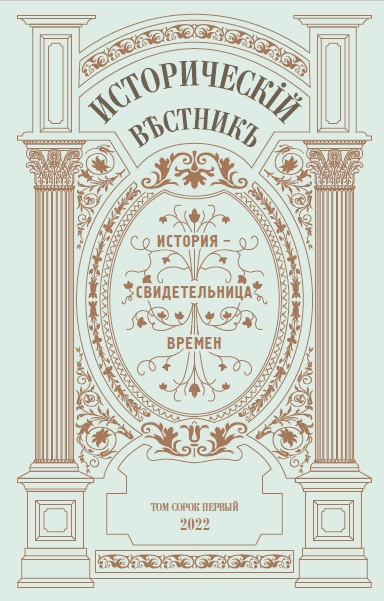
Кобищанов Ю. М. Теория большой феодальной формации // Исторический вестник. 2022. Т. XLI. С. 168–199.
В статье излагается теория большой феодальной формации, сформулированная историком и этнологом Ю.М. Кобищановым в 50–60-е гг. ХХ в. В рамках данной концепции переосмыслению подвергаются такие фундаментальные исторические феномены как «феодализм»; эволюция цивилизаций и протоцивилизаций; типы и подтипы личности феодальной формации, включая протокрестьян, классических и кастовых крестьян; условно-крупное и мелконатуральное производство, являвшееся основной ячейкой производительных сил феодализма; несопоставимость понятий «собственность» и «отношения владения»; взаимосвязь различных видов внеэкономического принуждения (государственного, общинно-кастового и духовного). Статья была впервые опубликована в 1992 г. в журнале «Вопросы истории» и переиздается в связи с уходом из жизни ее автора 29 июля 2022 г.
Ключевые слова: Ю.М. Кобищанов, феодализм, теория большой феодальной формации, крестьянство, отношения владения, виды внеэкономического принуждения.
Кобищанов Юрий Михайлович (1934–2022) – доктор исторических наук, главный научный сотрудник Института Африки РАН.
***
Kobishchanov Y. M. The Theory of the Great Feudal Formation // Historical Reporter. 2022. Vol. 41. P. 168–199.
Аннотация
Abstract
The article presents the theory of the Great Feudal Formation formulated by the historian and ethnologist Yuri M. Kobishchanov in the 50–60th years of the XX century. Within the framework of this concept, such fundamental historical phenomena as «feudalism»; the evolution of civilizations and proto-civilizations; types and subtypes of the personality of the feudal formation, including protopeasants, classical and caste peasants; conditionally large-scale and small scale natural production, which is the main cell of the productive forces of feudalism; the incompatibility of the concepts of «property» and «ownership relations»; the interrelation of various types of non-economic coercion (state, community-caste and spiritual ones) are being reinterpreted.
Keywords: Yuri M. Kobishchanov, feudalism, the theory of the Great Feudal formation, peasantry, ownership relations, types of non-economic coercion.
Yuri M. Kobishchanov – D.Sc. (History), Chief Researcher at the Institute of Africa of the Russian Academy of Sciences.
***
References
- Africa: cultural heritage and modernity [Afrika: kul’turnoe nasledie i sovremennost’]. Moscow: Nauka, 1985.
- African village yesterday and today [Afrikanskaya derevnya vchera i segodnya]. Moscow: Nauka, 1987.
- Agrarian structures of the Eastern countries: genesis, evolution, social transformations [Agrarnye struktury stran Vostoka: genezis, evolyuciya, social’nye preobrazovaniya]. Moscow: Nauka, 1977.
- BelyavskijV.A. Descendants of Ea-iluta-bani [Potomki Ea-iluta-bani] // Bulletin of Ancient history [Vestnik drevnej istorii]. 1968. № 1. P. 96–119.
- BelyavskijV.A. Shattinu son of Balatsu, descendant of Bel-yau [Shattinnu, syn Balatsu, potomok Bel-yau] // Countries of the Near and Middle East (history, economy) [Strany Blizhnego i Srednego Vostoka (istoriya, ekonomika)]. Moscow: Nauka, 1969. P. 21–38.
- BelyavskijV.A. Babylon legendary and Babylon historical [Vavilon legendarnyj i Vavilon istoricheskij]. Moscow: Mysl’, 1971.
- Bryant A.T. The Zulu People as They Were Before the White Man Came. Pietermaritzburg: Shuter and Shooter, 1949.
- Community in Africa: problems of typology [Obshchina v Afrike: problemy tipologii]. Moscow: Nauka, 1978.
- GulyaevV.I. Mayan city-states: the structure and functions of the city in early class society [Goroda-gosudarstva majya (Struktura i funkcii goroda v ranneklassovom obshchestve)]. Moscow: Nauka, 1979.
- HerskovitsM. Dahomey: an Ancient West African Kingdom. Vol. 1–2. N.Y.: J.J. Augustin, 1938.
- ItsR.F.,YakovlevA.G. On the question of the socio-economic structure of the Linshan group of the «I» nationality [K voprosu o social’no-ekonomicheskom stroe lin’shan’skoj gruppy narodnosti «i»] // Community and social organization among the peoples of Eastern and South-East Asia [Obshchina i social’naya organizaciya u narodov Vostochnoj i Yugo-Vostochnoj Azii]. Leningrad: Nauka, 1967. P. 64–106.
- KlemencD.A.,HangalovM.A. Public hunts among the northern Buryats: (zegate-aba — hunting for wolverines) [Obshchestvennye ohoty u severnyh buryat: (zegete-aba — ohota na rossomah)] // Materials on ethnography of Russia [Materialy po etnografii Rossii]. T.1. SPb., 1910. P. 117–154.
- KobishchanovYu.M. Spatio-temporal structures of the history of Africa [Prostranstvenno-vremennye struktury istorii Afriki] // Africa: the emergence of backwardness and ways of development [Afrika: vozniknovenie otstalosti i puti razvitiya]. Moscow: Nauka. Glavnaya redakciya vostochnoj literatury, 1974. P. 5–46.
- KobishchanovYu.M. African feudal societies: reproduction and uneven development [Afrikanskie feodal’nye obshchestva: vosproizvodstvo i neravnomernost’ razvitiya] // Africa: the emergence of backwardness and ways of development [Afrika: vozniknovenie otstalosti i puti razvitiya]. Moscow: Nauka. Glavnaya redakciya vostochnoj literatury, 1974. P. 85–291.
- KobishchanovYu.M. The peasantry and the proto-peasantry in Africa [Krest’yanstvo i protokrest’yanstvo v Afrike] // Asia and Africa today [Aziya i Afrika segodnya]. 1982. № 1. P. 38–40.
- KobishchanovYu.M. Small-scale production in the communal-caste systems of Africa [Melkonatural’noe proizvodstvo v obshchinno-kastovyh sistemah Afriki]. Moscow: Nauka, 1982.
- KobishchanovYu.M. Secret religious and magical societies [Tajnye religiozno-magicheskie obshchestva] // Traditional and syncretic religions of Africa. Religions in the XX century [Religii v XX veke. Tradicionnye i sinkreticheskie religii Afriki]. M.: Nauka i iskusstvo, 1986. P. 143–158.
- КottackС.P. Ecological Variables in the Origin and Evolution of African State: the Buganda Example // Comparative Studies in Society and History, Cambridge, 1972. Vo 14. № 3. P. 351–380.
- KrylovV.V. Features of the development of productive forces and the reproductive process in developing countries [Osobennosti razvitiya proizvoditel’nyh sil i vospro-izvodstvennogo processa v razvivayushchihsya stranah] // Economics of developing countries: theory and research methods [Ekonomika razvivayushchihsya stran: teoriya i metody issledovaniya]. Moscow, 1979. P. 152–185.
- LewisI.M. Peoples of the Horn of Africa: Somali, Afar and Sano. London: International African Institute, 1955.
- Lhote H. Les Touaregs du Hoggar. Paris: A. Colin, 1984.
- MaquetJ.-J. The Premise of Inequality in Ruanda: A Study of Political Relations in a Central African Kingdom. London: Oxford University Press, 1961.
- MaquetJ.-J. Une hypothèse pour études des feodalités africaines // Cahier d’études africaines. Vo 2. Issiue 6. 1961. P. 292–314.
- StuchevskijI.A. The temple form of the royal economy of Ancient Egypt [Hramovaya forma carskogo hozyajstva Drevnego Egipta]. Moscow: Izd-vo vostochnoj literatury, 1962.
- TyumenevA.I. The state economy of ancient Sumer [Gosudarstvennoe hozyajstvo drevnego Shumera]. Moscow-Leningrad: Izd-vo Akademii nauk USSR, 1956.

